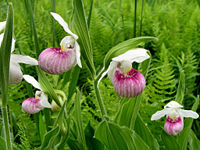Plant (organism): Difference between revisions
imported>D. Matt Innis (Dalton, just some copyedits - make sure I didn't change any meanings) |
imported>Joshua Choi (Starting to beef this article up) |
||
| Line 24: | Line 24: | ||
*[[Magnoliophyta]] | *[[Magnoliophyta]] | ||
}} | }} | ||
The | The '''green plants''' (from the Latin ''planta'', meaning "sprout") are those [[organism]]s classified into the [[kingdom (biology)|kingdom]] '''Plantae'''. Descending from a single [[common ancestor]], the plants take up a large portion of [[life]]—with estimates exceeding 285,000 [[species]]—and include many familiar and ubiquitous species including [[tree]]s, [[shrub]]s, [[cactus|cacti]], [[grass]]es, [[herb]]s, [[fern]]s, [[moss]]es, and [[green algae]]. Plants share certain characteristics—unlike [[animal]]s and [[fungi]], they do not voluntarily move, typically growing in a permanent site, passively absorbing [[nutrients]] and [[energy]] from their environment. In terms of both their total mass and their importance to other organisms, the green plants dominate [[ecosystem]]s in both [[land]] and [[freshwater]]. By harnessing [[sunlight]], they act as the primary sources of energy and [[food]] for all life in those ecosystems: green algae in freshwater and [[land plant]]s on the land. | ||
==Usage of the term== | |||
The term "plant" has gone through several definitions along history. | |||
[[Green algae]], for instance, were traditionally classified as [[protist]]s, but recent evidence has moved them into the plants along with the land plants. | |||
==Origin and phylogeny== | |||
Despite Phylogeny changing many of the concepts of how plants should be classified and what divisions remain, currently plants are informally divided among four main groups called; green algae, about 8.000 species; non vascular plants, or Bryophytes, circa 20.000 species; the ferns and horsetails, or [[Pteridophytes]], around 12,000; and seed plants, that is the largest group with 260,000 estimated species. These are split in twelve total divisions: | Despite Phylogeny changing many of the concepts of how plants should be classified and what divisions remain, currently plants are informally divided among four main groups called; green algae, about 8.000 species; non vascular plants, or Bryophytes, circa 20.000 species; the ferns and horsetails, or [[Pteridophytes]], around 12,000; and seed plants, that is the largest group with 260,000 estimated species. These are split in twelve total divisions: | ||
Revision as of 16:40, 3 May 2009
| Plantae | ||||
|---|---|---|---|---|
 Cypripedium reginae
| ||||
| Scientific classification | ||||
| ||||
| Divisions | ||||
The green plants (from the Latin planta, meaning "sprout") are those organisms classified into the kingdom Plantae. Descending from a single common ancestor, the plants take up a large portion of life—with estimates exceeding 285,000 species—and include many familiar and ubiquitous species including trees, shrubs, cacti, grasses, herbs, ferns, mosses, and green algae. Plants share certain characteristics—unlike animals and fungi, they do not voluntarily move, typically growing in a permanent site, passively absorbing nutrients and energy from their environment. In terms of both their total mass and their importance to other organisms, the green plants dominate ecosystems in both land and freshwater. By harnessing sunlight, they act as the primary sources of energy and food for all life in those ecosystems: green algae in freshwater and land plants on the land.
Usage of the term
The term "plant" has gone through several definitions along history.
Green algae, for instance, were traditionally classified as protists, but recent evidence has moved them into the plants along with the land plants.
Origin and phylogeny
Despite Phylogeny changing many of the concepts of how plants should be classified and what divisions remain, currently plants are informally divided among four main groups called; green algae, about 8.000 species; non vascular plants, or Bryophytes, circa 20.000 species; the ferns and horsetails, or Pteridophytes, around 12,000; and seed plants, that is the largest group with 260,000 estimated species. These are split in twelve total divisions:
- Chlorophyta: part of green algae
- Charophyta: the rest of green algae
- Marchantiophyta: liverworts
- Anthocerotophyta: hornworts
- Bryophyta: mosses
- Lycopodiophyta: club mosses
- Pteridophyta: ferns
- Cycadophyta: cycads
- Ginkgophyta: ginkgo
- Pinophyta: conifers
- Gnetophyta: gnetophytes
- Magnoliophyta: flowering plants